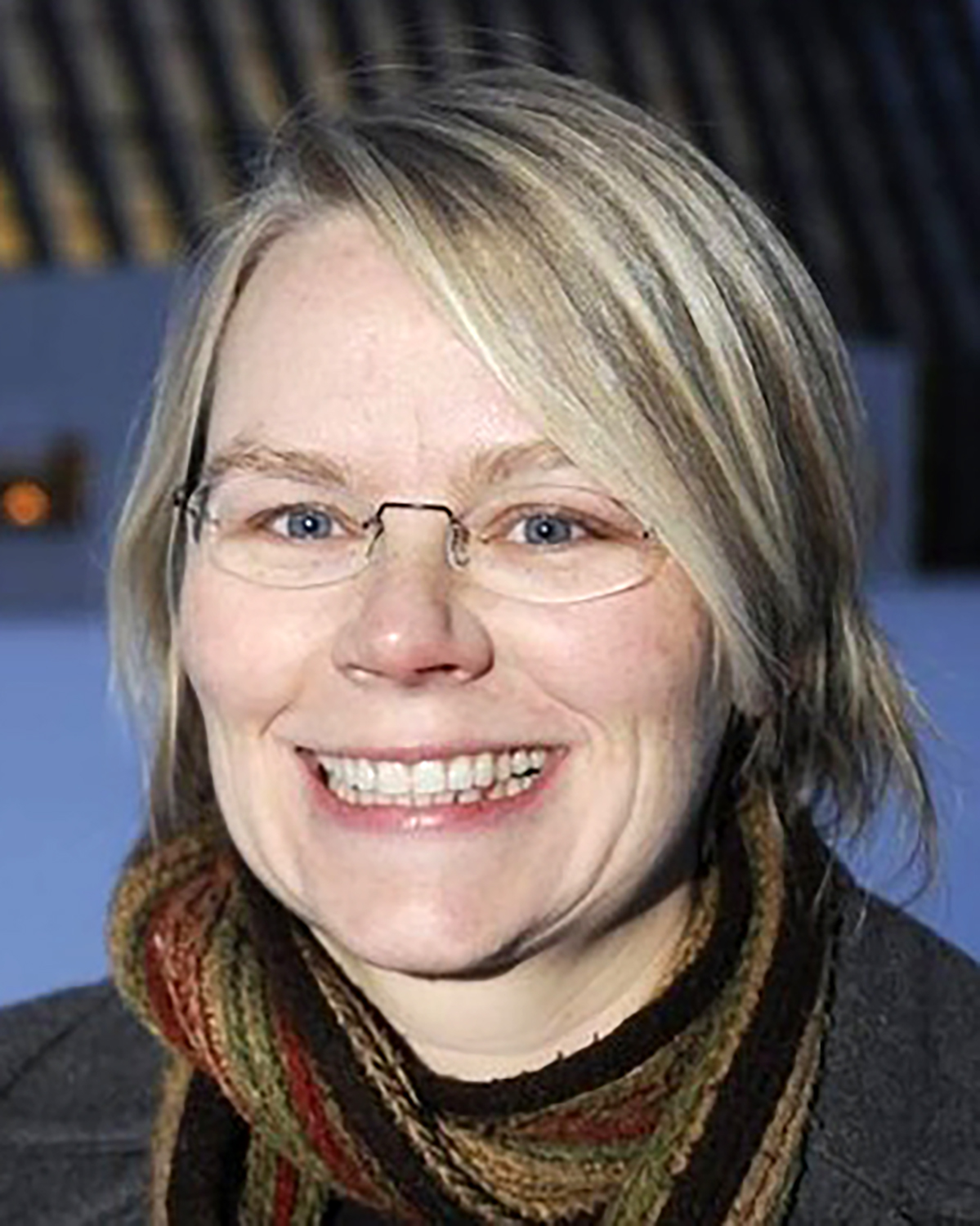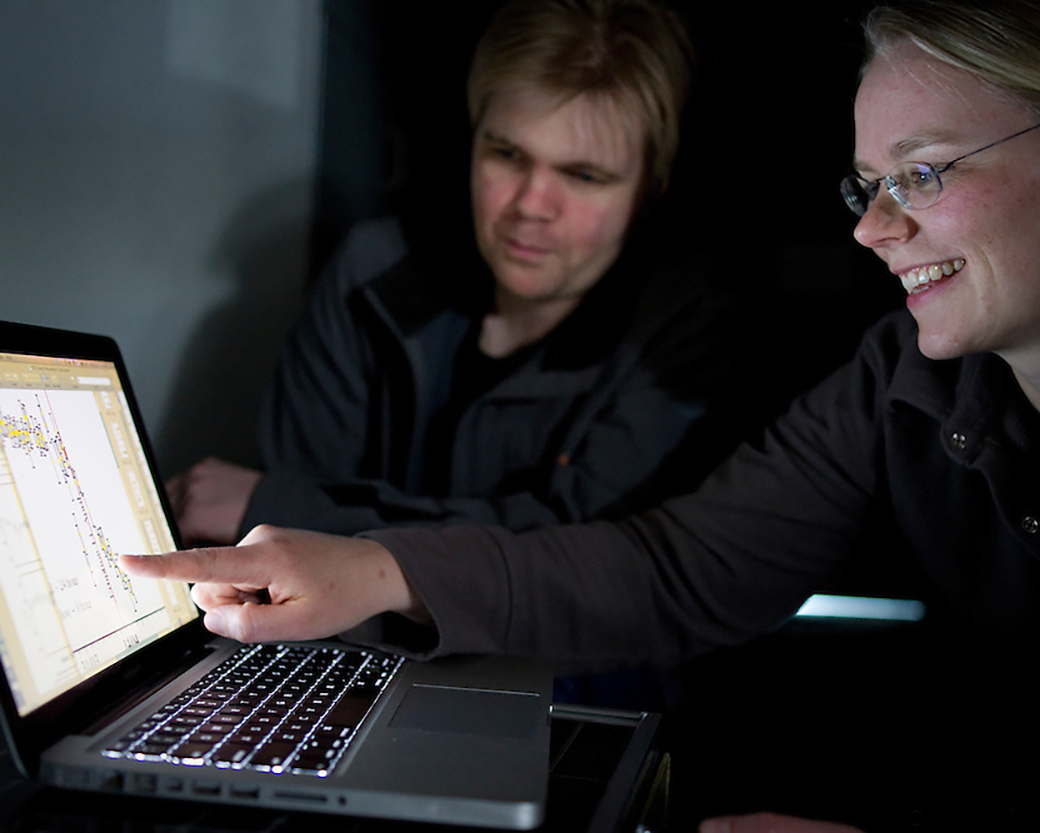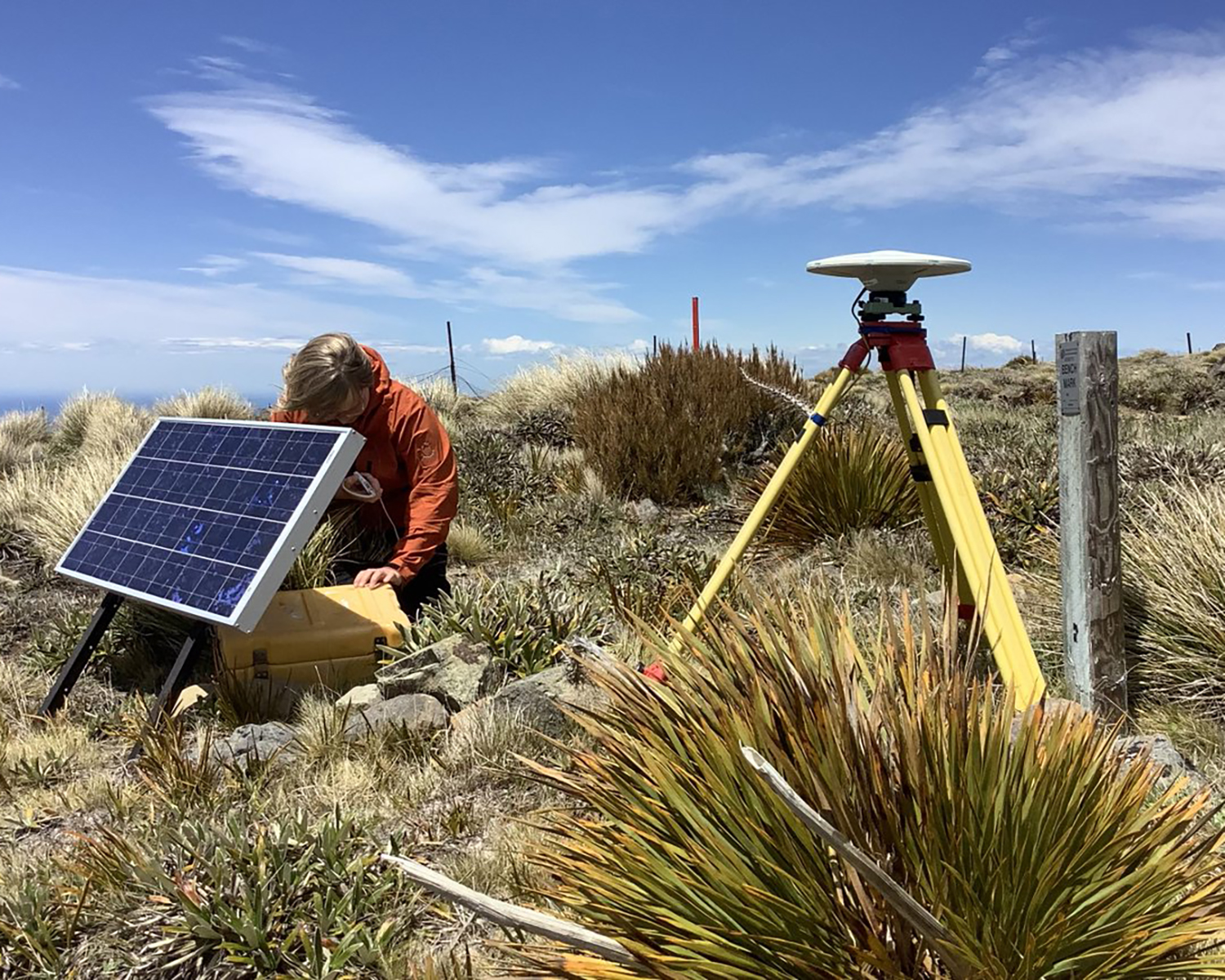Eyes on the Ground
Sigrún Hreinsdóttir
Profession: Geodetic Scientist, GNS Science

Degrees:
- Bachelor’s in Physics, University of Iceland
- Master’s in Geophysics, University of Iceland
- Docotorate in Geophysics, University of Alaska Fairbanks
Sigrun Hreinsdottir has traveled all over the earth to study the earth under her feet. The Iceland native received a Ph.D. at UAF and now studies seismic activity in New Zealand. She describes her career path as unexpected but supremely rewarding.
Please tell me about the work that you do.
I am a Geodetic Scientist at GNS Science, a government research institution in New Zealand. We do research to better understand earthquake hazards, volcanic hazards, and the impact of climate change. My field research is measuring the surface of the earth at very high precision to study earthquakes, tectonics, and volcanology. I am currently working on a project looking at how the coastline in New Zealand is going up or down, to evaluate the impact of climate change.
I am also working on a volcano in Iceland right now. Often, prior to an eruption we get a pre-eruptive signal. If there’s a magma chamber in the volcano, we can see how it inflates prior to an eruption. What’s happening in Iceland right now is that magma came from 20 kilometers deep and traveled up through the earth’s crust, it filled in a dike, and then it erupted. With these GPS measurements we can see very precisely how the crust responds to magma coming in and we can model that and then evaluate how much magma has come into the crust and the depth that it is coming into the crust. Basically we can see how the surface is moving and infer from that what is going on in the ground.
I was also involved in a magnitude 7.8 earthquake in New Zealand in 2016, and I studied the 2002 Denali earthquake in Alaska. We can see how the earth moved during an earthquake. Sometimes it is big movements, maybe meters. On the Kenai Peninsula I saw millimeters of movement from the Denali earthquake. So, we can see big and small movements and from those we can infer how the earth was ruptured during the earthquake.

Examining a GPS in the field.
What’s even more interesting is that following an earthquake the crust continues to respond and we can actually monitor how the earth is moving for years and decades after. With tectonics we see how the crust is moving in the background, which faults are building up stresses, and if you have a fault that hasn’t erupted for a long time we can see if it is active or not.
I am focused on a GPS technique that allows me to look at various things, you never get bored, there are always things to look at. We have stations all over the world that collect continuous GPS measurements, they measure every second, and I can take this data and evaluate it. We combine that data with satellite measurements and seismic measurements to build a good picture of what’s going on.
What was your journey like to get to where you are in your career?
I grew up in Iceland and we have fairly frequent eruptions and earthquakes. Everyone who is brought up in Iceland is a geoscientist, in my point of view. We are all so aware of our country - of the hazards, and nature, and how Iceland formed. During an eruption in Iceland everyone wants to see it, everyone is looking at the lab cams and following the seismicity.
When I was growing up I really wanted to be a mathematician, but I realized I thought it was boring so I decided to switch to physics. While I was doing my physics degree I started taking geology classes just as a fun thing. Then I learned about geodesy and I became fascinated – it combines physics, math, geology, and fieldwork. It was like “this is it, this is what I want to do!” It is quite rewarding in many ways. You get to do field work, work with data, work with the models, and you get to improve understanding of these processes. I get to go out in the field and try to understand what’s going on in relation to eruptions and earthquakes, and how Iceland became Iceland.
I decided to do my master’s degree in Iceland. I was measuring the country and figuring out if there was volcanic activity and what the buildup of stresses for future earthquake were. I wanted to continue and do a Ph.D. I had just one criterion – I wanted to be in an English-speaking country. When you are a scientist the English language is quite important and in Iceland we speak Icelandic. I always struggled with languages and I wanted to embed myself into the science in a country that spoke the language that you write you science papers in.
What led you to Alaska in particular?
My advisors in Iceland had connections and I got in contact with three professors, one in Alaska. When he told me about the opportunities in Alaska I thought it was just great. He was a really inspiring, top-notch scientist so I felt very privileged to be able to join his team in Alaska.

Hreinsdottir during fieldwork on New Zealand’s South Island, studying deformation from the 2016 earthquake.
I was supposed to study the subduction zone and post-seismic deformation from the 1964 Prince William Sound earthquake. I did a lot of field work related to that and even went in a helicopter all over that area. But the Denali earthquake happened while I was doing that, and it really impacted my fieldwork because everything moved in Alaska during the Denali earthquake and it caused offsets in all of the data. My thesis took a 180-degree turn and I ended up looking at earthquake deformation from Denali.
It was the largest earthquake in 2002 I believe; it was magnitude 7.9 and it ruptured the Denali fold for 300 kilometers. It happened in October and I remember there was snow on the ground and black ice on the roads so it was the scariest fieldwork because we were driving really fast to get to the area, but the roads were all destroyed. It also had geological features that I had never seen before because my background was more physics, I was seeing more geology than I had learned about and it was really quite impressive. For example, when you pressure the crust like that you get little mud geysers and they were all over the place.
We were installing new tools and measuring points all over the place. We were changing batteries in the middle of winter, dragging batteries on sleds to a site. It was quite a lot of fun because usually you do field work in the summertime but here there was an event that caused us to do a lot of fieldwork in the middle of winter.
They were harsh conditions, but it was good to get out there. The sooner you get out there, the more important the data is going to be because you catch more of what happened in the earthquake and it’s not spoiled by what happens a few days after. I have always been so interested in this that I will be the first one to run out into the field. I don’t care if I am going to work on the data myself or if I am helping someone else, I just know how valuable the data is.
It sounds like you chose an adventurous career.
Initially when I went to do my Ph.D in Alaska I wanted to study volcanoes, but none of the volcanoes wanted to move while I was there. The earthquake replaced that activity. When you are doing geophysics in a place that is active like Alaska, Iceland, New Zealand, Italy, or any of these places that I have worked, it seems like there is nonstop activity. It seems like there is always another event around the corner.
I don’t know what I thought my life would be like, but I never in my wildest dreams thought it would be what it is. I’ve always jumped at opportunities that have opened up, and it is never boring to be in this field.

Hreinsdottir at work.
Geophysics is also quite rewarding because it is such a new field, in geological terms, so we are still discovering things every year. We haven’t had GPS measurements that we could use to do this work until the late 1990s. So, we are always learning something new; always finding something that surprises us.
Have there been any challenges or barriers unique to your journey that you’ve come across?
There are a few things that I struggled with, and I still struggle with. Number one is that I am really good at saying “yes.” So, the pile of projects just builds up, but there is just a limited number of hours in the day. To be able to say “no” to very exciting things is still a challenge today, but at some point, you need to step back and finish what you were working on so that other people can benefit from that.
The other thing is that I have two kids and I had my first kid when I was in America and really struggled with the family-work balance. I think I never quite recovered from the fact that I had to go back to work so early. It was a real challenge and I was very stressed during my maternity leave. In Iceland you get half a year or something off for maternity leave, and in New Zealand it is three months paid time off and then you can have up to a year after that. When I had my second kid in New Zealand I took six months off from work and it was wonderful. I came back energized, and I felt like I could continue on projects. I really wish Americans would think a little bit about that; if they want women in science they need to allow to have women to have time with their babies while it is important and it is critical for the bonding.
What is some advice that you would give to STEM students?
First of all – you can change careers. If you go and do a master’s degree in one field, you can change later on. Scientific thinking is the most important thing that you learn during grad school; how to do research. So, don’t ever think that you are stuck on a path. I know many people who have done a master’s degree and then changed to do either another master’s degree or a Ph.D in a different field.
Also, being good at school or being bad at school is no indication of how you are going to be as a researcher. It is just not the same thing. I was never an A+ student, but I really enjoy research. You cannot say that being good or bad at taking an exam means that you’re good or bad at doing research. You cannot equate those things. If you decide to go down the grad school pathway, try to do it in a subject that you are passionate about or really interested in because there is nothing harder than trying to write a thesis about a subject that you are not passionate about. Everybody is passionate about something.

Hreinsdottir working on a Global Navigation Satellite System station on New Zealand’s South Island, studying deformation from the 2016 earthquake.
You should research a particular professor and see what they are doing before you decide to do a master’s degree or a Ph.D with them. If your interests don’t align, that is going to be very hard. I am really glad that I selected the University of Alaska Fairbanks. I know some people think that you have to go for the high-prestige schools, but in reality, the research you will be doing and the professor you are doing your study with is more important in the long run than the name of the school on your degree. People are not looking up what school you are from, they are looking up your papers, and there are really good faculty at the University of Alaska - it is really rich in good-quality researchers.
Is there anything else you want to add?
I often think back to my life in Alaska. It was an adventure. When I decided to go to Alaska I knew a girl who lived in a cabin in the woods without any running water and I was absolutely horrified by this idea. But after living in Alaska, that’s what I wanted to do. It was a wonderful experience; seeing the aurora in the middle of the night when you go to the outhouse… memories like that are quite precious.
The other thing was, I spent a good two months in the field every year and was able to go to remote places and get to know communities. It is still very fresh in my memory when we went porcupine hunting and things like that, that you would never experience anywhere else. I went down in Prince William Sound on a boat, flew to Montague Island in a helicopter, went to Katmai in a float plane. When I think back on this, I lived such an adventure while I was doing my PhD. I feel really fortunate and lucky.
I also knew myself that I might not have done so well in a really competitive environment. I like to work with people, not trying to beat people. I thought the University of Alaska would be a better community for me and I think I was absolutely right. Some of my best friends are still in Alaska. I had this core group of people who were going through the same thing as me, doing a PhD or master’s degree. It is a process that is not always fun, and the support of the student network was so important. I think that the University of Alaska has a really strong student support network and the way that I was embedded into that without being a super social person was really nice.
During school breaks we did adventurous things like going hiking, climbing, skiing, and going to cabins. I got married to my husband in Alaska, we skied to a cabin. I am really glad that I had this experience. That university still has my heart.
Interview by Courtney Breest, Alaska NSF EPSCoR. Click here for more Faces of STEM.


